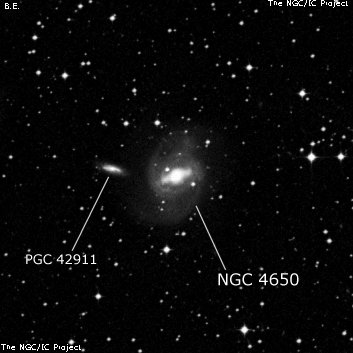
John Herschel discovered NGC 4650 = h3413 on 26 Jun 1834 and recorded "vF; R; bM; r. Wind violent." He later added the note "Right reduced. The degree of PD certainly correct." His position is accurate, though MCG does not label this galaxy as NGC 4650.
Joseph Turner observed this galaxy, along with NGC 4622, in July 1876 with the Great Melbourne Telescope (unpublished plate V, figure 58) but failed to notice any of the surrounding galaxies. He called it "small; extremely faint; center has somewhat of a stellar character; quite round; appearance of a faint halo." Pietro Baracchi observed the surrounded field on 19 and 20 Mar 1885 with the GMT and described NGC 4650 as "pB, S, R, gsmbM, small star south-preceding near it." In addition he discovered 6 nearby galaxies; NGC 4622A, 4550A, ESO 322-075, NGC 4603A, ESO 322-047 and NGC 4603C. He
400/500mm - 17.5" (4/7/89): very faint, small, oval WNW-ESE, bright core. Appears slightly brighter than NGC 4622A 5.8' WNW. Member of the Centaurus cluster (AGC 3526).
600/800mm - 24" (4/12/08 - Magellan Observatory, Australia): at 200x appeared bright, fairly large, round, strong even concentration with a very bright core inceasing to a small nucleus. A faint star is on the west side of the halo. NGC 4650A, a famous polar-ring galaxy, lies 5.6' ENE and PGC 42911 is a mere 1.9' E of center. The close companion appeared fairly faint, fairly small, elongated 2:1 ~E-W, 0.6'x0.3', even surface brightness.
900/1200mm - 48" (4/21/17): at 488x; bright, moderately large, round, sharply concentrated with an intense core surounded by a roundish, mottled halo ~1 diameter. A mag 15 star is 0.5' SW of center at the edge of the halo and a mag 15.5 star is 0.3' NE of center in the halo.
PGC 42911, situated just 1.8' E, appeared fairly faint, fairly small, very elongated 5:2 E-W, 0.6'x0.25', low surface brightness. NGC 4650A, a well-known polar ring galaxy 5.7' ENE, appeared fairly faint to moderately bright, fairly small, oval 4:3 or 3:2 WSW-ESE, small brighter core. The polar ring extensions were extremely faint and difficult, though viewed in windy conditions.
48" (5/12/12): NGC 4650A appeared moderately bright, fairly small, oval 3:2 WSW-ESE, 24"x16". The polar ring was occasionally visible as faint, thin extensions oriented NNW-SSE. Need to reobserve as viewed through thin clouds.
Notes by Steve Gottlieb